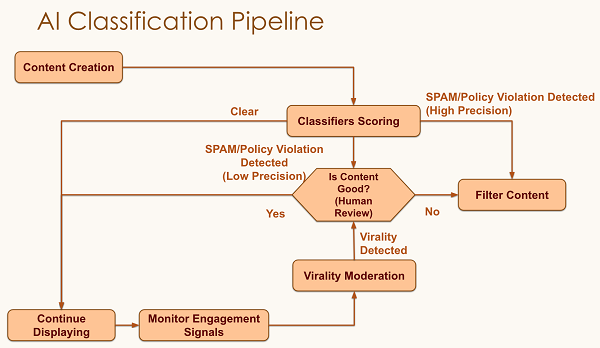LinkedIn has shared a new technical overview of its efforts to combat viral spam in the app, which also provides some interesting notes on how its feed algorithm works, and how content gains traction in the app.
Which could help in your strategic planning – or at the least, it’ll help you understand the factors that weigh into LinkedIn’s algorithmic flow, which ultimately dictates post reach.
First off, LinkedIn notes that its platform is not designed to maximize the reach of popular posts the way that other social apps are:
“LinkedIn is not designed for virality but on occasion posts that result in significant engagement in the form of likes, reactions, comments, and reshares in a short period of time could be considered viral.”
LinkedIn is more aligned with community building and niche relevance, which is why amplifying all the most popular posts doesn’t really work within the context of the app. But posts that generate a heap of engagement will still be more widely shared as a result – and of course, everyone trying to maximize their performance in the app is working towards post optimization, however they can.
So how can you maximize post reach?
In the overview, LinkedIn explains how its system detects potentially viral content, and stops potentially violative posts:
“As soon as a piece of content surfaces, the existing ML classifiers act based on the immediate features that can be computed, such as author and content related features. If it is found to be spam or policy-violating, then we either take an automatic action or send it for human review to decide on the action to be taken. For the content that is still present on the platform, we monitor the engagement signals, temporal signals, and spam related signals to detect the potential for viral spam during the content lifecycle on the platform.”

So LinkedIn’s telling us that the key factors that weigh into the performance of a post are:
- The post author
- Engagement signals
- Temporal signals (velocity of likes/reactions, shares, comments, and views)
In terms of post author, LinkedIn says that its system measures:
“The influence and popularity of [members posting and engaging with a post] as their action might expose the post to a lot more members creating a cascade effect which makes the post go viral. Here, we use features such as followers and connection counts, diversity in industry, location, and level of the network (connections and followers) of these members.”
Note that LinkedIn uses the term ‘members’ not ‘users’, because LinkedIn doesn’t share data on actual user counts, only total members.
In terms of engagement signals, LinkedIn says that it then measures the likes and reactions for each post, along with shares, comments, and views.
“We derive various features from these such as temporal sequences of counts and velocity of likes, reactions, shares, comments, and views. These act as the strongest signal for the cascading effect happening in the network.”
So velocity is important, but the main factors in gaining maximum traction on LinkedIn are likely as you would expect:
- The number of followers that you have
- The number of connections that you have
- Diversity considerations (more vague)
- Your location
- The seniority of users in your network
- The velocity of engagement with post
LinkedIn doesn’t specifically note that either likes, comments or shares weigh more heavily, but that’s also likely another element in its ranking system.
So, best to start building your LinkedIn audience, and hoping that most of them stick around as followers. Follower counts logically count for more than basic connections, though both are factors – but it is also worth noting that once someone has connected to you, they can still unfollow you and remain a connection.
You can check your follower count in your LinkedIn feed settings.
After that, you just need to post engaging content. Which is not necessarily easy, but by monitoring your feed, and studying what’s working for others, you can get a better idea of posting best practices. Here’s an overview of the most shared LinkedIn posts of 2022.
In terms of spam detection – the focus of LinkedIn’s update – LinkedIn says that its systematic updates have led to significant improvements in the detection and removal of violative content, with the overall percentage of views on spam declining by 7.3%.
So it’s improving its systems, while also providing some extra insight into the workings of its algorithm.
You can read the full post on the LinkedIn Engineering blog.



